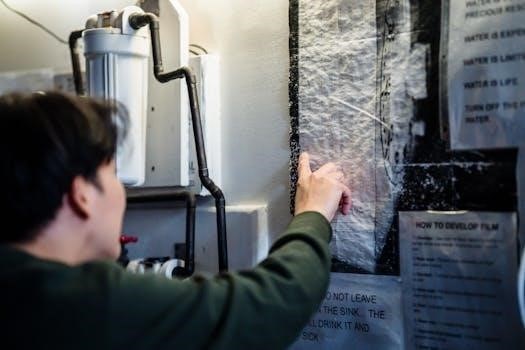Dyna 2000i Overview
The Dyna 2000i is a digital ignition system created to supplant the factory module and sensor on 1983 and later Harley-Davidson EVO engines․ This system is a self-contained upgrade to the stock electronic ignition found in later model Harleys․
Description of Dyna 2000i
The Dyna 2000i Digital Ignition System is a microcomputer-controlled unit designed for Harley-Davidson motorcycles․ It provides highly accurate control over ignition timing․ This system serves as a comprehensive upgrade to the electronic advance ignition systems found in late-model Harley motorcycles․ The unit is designed to replace the factory ignition module and sensor used on 1983 and later Harley-Davidson EVO motors․ It’s also a great choice for upgrading from earlier electronic and breaker-point systems․ The 2000i allows for reprogramming of advance curves and RPM limits when used with the optional DIPK-1 kit․ Furthermore, engine run-time data can be downloaded using the programming kit, allowing for in-depth analysis of engine operation․ The system offers both single- and dual-fire modes and includes 8 advance curves and 4 RPM limits to accommodate diverse engine builds and riding preferences․ A single-stage retard feature is also provided for bikes equipped with nitrous or turbo systems․
Replacement for Factory Ignition
The Dyna 2000i is specifically engineered as a direct replacement for the factory ignition module and sensor found on 1983 and later Harley-Davidson Evolution (EVO) engines․ This makes it a seamless swap for riders looking to upgrade their ignition system without extensive modifications․ This digital ignition system is not just a replacement; it’s an upgrade․ It supersedes the limitations of stock electronic advance systems․ The Dyna 2000i also serves as a superior alternative for older electronic or breaker-point ignitions, offering enhanced performance and reliability․ The system’s microcomputer control ensures significantly more accurate ignition timing․ It offers a substantial advantage over older systems that are often less precise․ By replacing the factory ignition with the Dyna 2000i, riders can expect improved engine performance, smoother operation, and better overall control․ This ignition system provides a modern solution to aging and less efficient factory ignitions․

Dyna 2000i Features
The Dyna 2000i boasts several key features, including microcomputer control, reprogrammable advance curves, single and dual fire modes, and adjustable RPM limits․ These features provide enhanced engine management and customization․
Microcomputer Controlled Ignition
The Dyna 2000i utilizes a microcomputer to manage the ignition process, which allows for extremely precise control over the timing and delivery of the spark․ This level of precision is not typically achievable with traditional mechanical or analog ignition systems․ The microcomputer’s ability to rapidly and accurately adjust to changing engine conditions contributes to improved performance, fuel efficiency, and overall engine smoothness․ This advanced control is essential for optimizing engine output across various operating ranges and load conditions․ The system continuously monitors engine parameters and adjusts the ignition accordingly, ensuring optimal combustion and reducing the risk of detonation․ This precise control allows riders to fine-tune their motorcycle’s performance to their specific needs and riding style, making it a valuable upgrade for enthusiasts and performance-oriented riders․
Reprogrammable Advance Curves
The Dyna 2000i offers the significant advantage of reprogrammable advance curves, allowing users to customize the ignition timing to match their engine’s specific characteristics and performance goals․ This feature provides flexibility beyond the limitations of fixed advance curves found in standard ignition systems․ With the optional DIPK-1 programming kit, users can easily adjust the advance curve to optimize performance for different engine configurations, riding styles, and fuel types․ This capability is particularly beneficial for those who have modified their engines or are looking for peak power and efficiency․ The reprogrammable nature of the Dyna 2000i allows for a more tailored and optimized riding experience․ The ability to modify the advance curves also allows for fine tuning the engine to reduce any unwanted noises or vibrations․
Single and Dual Fire Modes
The Dyna 2000i provides the flexibility to operate in either single-fire or dual-fire mode, catering to a wide range of engine setups and preferences․ In single-fire mode, each cylinder is ignited independently, resulting in a more precise and efficient combustion process, especially beneficial for high-performance applications․ This mode also reduces the chance of wasted spark․ Dual-fire mode, on the other hand, fires both cylinders simultaneously, which is more common in stock configurations․ The ability to switch between these modes makes the Dyna 2000i adaptable to various Harley-Davidson models and engine modifications․ It allows users to select the ignition mode best suited for their specific needs․ Selecting the correct ignition mode is an important step when installing the module, so make sure that it is configured correctly․
RPM Limits and Advance Curves
The Dyna 2000i incorporates eight distinct advance curves and four different RPM limits, offering a high degree of tunability for a variety of engine builds and riding styles․ The advance curves dictate how the ignition timing changes with engine speed, directly impacting performance․ With the correct curve, riders can optimize power delivery and overall engine performance․ The four available RPM limits allow users to set a maximum engine speed, helping to prevent over-revving and potential damage․ These adjustable limits and curves ensure that the ignition system can be tailored to match the unique characteristics of each motorcycle and riding style․ This customization feature provides the user with significant control over how their motorcycle operates․

Dyna 2000i Installation and Configuration
The Dyna 2000i features six mode switches which are utilized to configure the ignition for your specific engine setup and riding preferences․ A label is provided to be placed inside the cam cover for future reference․
Mode Switch Configuration
The Dyna 2000i utilizes a series of six mode switches to allow users to tailor the ignition system to their specific engine builds and riding styles․ These switches enable the adjustment of various parameters, ensuring optimal performance for a wide range of setups; Proper configuration of these switches is crucial for achieving the desired ignition characteristics․ The first switches are dedicated to specific advance curve selection, allowing you to choose from various pre-programmed curves to match your engine’s needs․ These curves dictate how the ignition timing advances with engine speed, influencing overall performance and fuel efficiency․ The last switches allow for RPM limits and single or dual fire modes․ It’s essential to consult the included manual for a detailed explanation of each switch’s function and the recommended settings for your setup․ Careful attention to the switch settings will ensure that your engine operates smoothly and efficiently․ Incorrect settings may result in poor performance or even engine damage․
Switch Position Label
Included with the Dyna 2000i is a switch position label that plays a vital role in simplifying future adjustments․ This label is designed to be affixed to the inside of the cam cover, providing a readily available reference guide for the mode switch settings․ By placing the label in this location, you can easily recall the current configuration without needing to consult the manual each time․ This is especially useful when fine-tuning your engine’s performance or switching between different riding styles․ The label clearly indicates the function of each switch, as well as the associated settings for each position․ This eliminates guesswork and makes on-the-fly changes more convenient․ The switch position label is a small but essential component of the Dyna 2000i system, contributing to ease of use and ensuring that you can always quickly verify your settings․ Always ensure that the label is securely attached to the inside of the cam cover for easy and reliable reference․

Dyna 2000i Programming
The Dyna 2000i can be reprogrammed with custom advance curves and RPM limits․ This is achieved using the optional DIPK-1 programming kit․ Engine run-time data can also be downloaded․

Using Optional DIPK-1 Kit
The optional DIPK-1 programming kit is essential for customizing the Dyna 2000i’s performance․ This kit allows users to modify advance curves and RPM limits, tailoring the ignition system to specific engine builds and riding styles․ With the DIPK-1, you gain the ability to fine-tune the ignition timing to optimize power output and efficiency․ This is crucial for those seeking peak performance from their Harley-Davidson motorcycles․ The kit connects to the Dyna 2000i, enabling users to upload new settings and experiment with different ignition characteristics․ It offers a user-friendly interface for making these adjustments․ Furthermore, the DIPK-1 kit is not just for adjustments, it also allows you to download valuable engine run-time data, which is beneficial for diagnosing and optimizing your engine’s performance․ This data can reveal critical information about operating conditions, which can help you to make more precise adjustments with the kit․
Downloading Engine Run-Time Data
The Dyna 2000i, when paired with the optional DIPK-1 programming kit, offers the ability to download engine run-time data․ This feature provides valuable insights into how the engine is performing under various conditions․ This data can be instrumental in diagnosing potential issues, fine-tuning engine performance, and optimizing the overall riding experience․ The information downloaded includes parameters like RPM, ignition advance, and other critical engine metrics․ By analyzing this data, users can identify areas where adjustments to the ignition system might be needed․ This capability is particularly useful for those who have made modifications to their motorcycle․ Accessing this data enables precise adjustments to the ignition system, ensuring that the engine is operating at its peak performance․ It is a powerful tool for both enthusiasts and professional mechanics․
